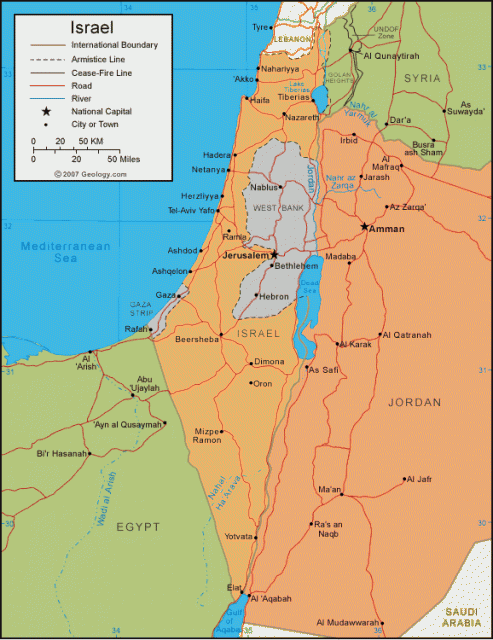Israel
Area 8,019 square mi (20,770 square km)
Population 8.215 million 2014
Capital Jerusalem
Highest Point 3,974 ft (1,208 m)
Lowest Point -1,338 ft (-408 m)
GDP $304.2 billion 2014
Primary Natural Resources timber, potash, copper ore.
THE STATE OF ISRAEL is located on the eastern shore of the MEDITERRANEAN SEA, bordering the Gaza Strip to the southwest, EGYPT to the southwest, the West Bank to the east, JORDAN to the east and southeast, SYRIA to the northwest, and LEBANON to the north. Israel is a parliamentary democracy with the Knesset as the legislature. The president serves as chief of state, while the prime minister serves as the head of government. Hebrew and Arabic serve as the official languages of Israel, but English is widely used as a foreign language. Jerusalem, Tel-Aviv, and Haifa are the major cities.

The landscape of Israel is varied. The coastal plain stretches from Gaza in the south to Haifa in the north, covering 291 mi (469 km). Mountains traverse north to south in the central part of the country. The Sharon Plain stretches from Haifa to the Yarkon River, from which begins the Shefala Plain, which continues through Gaza. The Jordan River is Israel's main source of water and forms the border with Jordan. The Negev Desert makes up the southern portion of the country. Northern Israel receives average rainfall of 39 in (1,000 mm), while Eilat receives .8 in (20 mm). The country is susceptible to sandstorms during the spring and summer and periodic earthquakes.
Israel was part of the FERTILE CRESCENT that stretched from Mesopotamia. The Hebrew-speaking Semitic people who became the Jews settled in this region 3,500 years ago. A Judean kingdom was founded by King David, which survived until 586 B.C.E. when the Babylonians destroyed the First Temple and Jerusalem and sent part of the population into exile. Thereafter, the region fell under the sway of Persians, Greeks, Romans, Muslims, Crusaders, and the Turks.
In 1897, Theodore Herzl, after witnessing European anti-Semitism, founded a Zionist movement, which called for a Jewish homeland in Palestine. Between 1882 and 1903, Jews from all over Europe settled in Palestine and founded communities. These new settlers faced problems of poor soil, lack of experience, and opposition from Arabs and Turks.
A turning point in the formation of Israel as a modern state came during World War I. When the war broke out in 1914, the Ottoman government began expelling Jewish settlers in PALESTINE, whom it declared “enemy aliens.” On November 2, 1917, the Balfour Declaration established official British support of a “national home for the Jewish people.” At the end of the war, the OTTOMAN EMPIRE was dismantled, and the League of Nations officially recognized the British Mandate for Palestine. In 1939, with war against Adolf Hitler's Germany looming, Britain issued the White Paper, which voiced its support for the creation of an Arab state for all of Palestine, barring Jewish emigration to the area.
By February 18, 1947, the British government ended the mandate on Palestine, leaving its fate to be decided by the newly formed United Nations (UN). The new UN Security Council faced the decision of whether to vote on the partition of Palestine into a Jewish and Arab state. As a result of the influence of the United States, the Security Council voted for the partition of Palestine.
On May 14, 1948, David Ben-Gurion declared the independence of the State of Israel. Between 1948 and 1973, Israel fought a series of wars with American support against the Arab states in order to maintain its existence. After the Six Day War in 1967, Israel gained control of the West Bank and East Jerusalem from Jordan; Gaza Strip and the SINAI PENINSULA from Egypt, and the GOLAN HEIGHTS from Syria. After meeting in Camp David in 1977, Prime Minister Menachem Begin of Israel and President Anwar Sadat of Egypt signed the Israeli-Egyptian Peace Treaty in 1979, marking the first time Israel made peace with an Arab state.
Since 1979, there has been a movement toward securing peace between Israel and its Arab neighbors. In 1991, the Madrid Conference called for talks on a final peace settlement. In 1993, through the Oslo accords, Israel and the Palestinians worked toward ending occupation of the West Bank and the Gaza Strip, paving the way for a Palestinian state. In 1994, Israel signed a peace treaty with Jordan. However, by September 2000, renewed hostilities flared between Palestinians and Israel, undermining the gains that had been made toward a permanent settlement.
The Israeli population is 80 percent Jewish. Of that percentage, 32 percent is from Europe, while 15 percent is of Asian descent and 13 percent is of African descent. The remainder of Israel's population is mostly Arab.
Israel has a market economy that includes a significant government role in economic policy. There have been great advances in the increase of agricultural output despite its limited arable land. There has been a significant growth in the technological sector of the economy. The addition of Jews from the former Soviet Union has also revitalized the economy. However, the government has a sizable foreign debt, particularly with the UNITED STATES. Israel's economic prospects continue to be overshadowed by the uncertainty of the Israeli-Palestinian conflict.